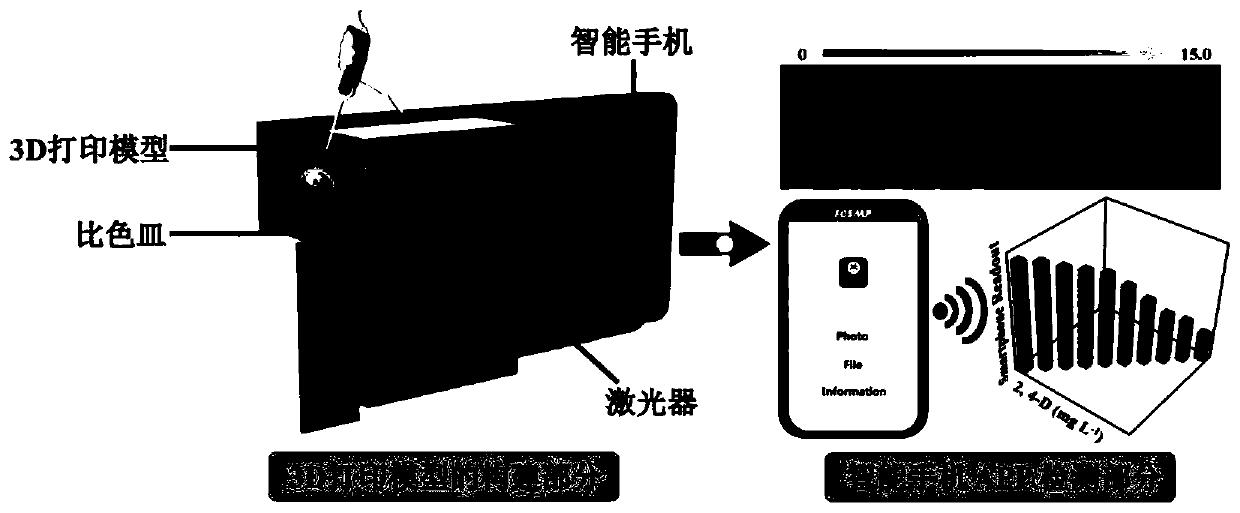2, 4-dichlorophenoxyacetic acid on-site quantitative detection platform based on integration of target response type 3D printing model and smart phone
A 3D printing and smart phone technology, applied in the field of biosensors, can solve the problems of cumbersome test methods, poor test stability, inconvenient portability, etc., and achieve the effects of low cost, good stability, and improved selectivity
- Summary
- Abstract
- Description
- Claims
- Application Information
AI Technical Summary
Problems solved by technology
Method used
Image
Examples
Embodiment 1
[0037] Embodiment 1: Preparation of CDs / CoOOH composite material
[0038] First, add 1.0g of citric acid and 2.0g of urea into 10.0mL of N,N-dimethylformamide solution (≥99.9%), stir for 10min, react at a constant temperature of 160°C for 6h, and wash with alkali after cooling ( 20mL, 1.2mol L -1 Sodium hydroxide aqueous solution), pickling (25mL, 5wt% hydrochloric acid solution), centrifugation after washing, and freeze-drying to obtain CDs; secondly, 3.0mL, 1.0mol L -1 Sodium hydroxide aqueous solution and 10.0mL, 10.0mmol L -1 500 μL, 0.9mol L -1 The aqueous solution of sodium hypochlorite was added and ultrasonicated for 15 minutes, and the aqueous solution of CoOOH nanosheets was obtained after centrifugation. 5.0mL 0.3mg mL -1 CDs aqueous solution and 5.0mL CoOOH nanosheet aqueous solution (0.025mg mL -1 ) were mixed and stirred for 10 min, and centrifuged to obtain an aqueous solution of CDs / CoOOH composite material.
Embodiment 2
[0039] Example 2: Acquisition of Smartphone Assisted Images
[0040] 50 μL of 2,4-D aqueous solution (1.0 mg L -1 ) and 50μL ALP aqueous solution (7.0U L -1 ) were mixed and incubated at 37°C for 30 min to achieve the inhibition of ALP activity by 2,4-D; subsequently, 120 μL of L-ascorbic acid-2-phosphate trisodium salt solution (100 μmol L -1 ) and 100 μL Tris-HCl buffer solution with a pH of 8.0, after incubating at 37°C for 10 minutes, the aqueous solution (160 μL) of CDs / CoOOH composite material prepared in Example 1 was added and mixed evenly; after equilibrating at 25°C for 10 minutes, the ratio Put the color dish into the 3D printing model, and obtain the corresponding red fluorescent picture under the concentration of 2,4-D in this example under the 532nm laser. Under the 2,4-D concentration in this example, the grayscale value of the image corresponding to the sample read by the mobile phone is 42.57.
Embodiment 3
[0041] Embodiment 3: Application of APP to 2,4-D detection
[0042] According to the method of Example 2, different concentrations of 2,4-D (0.1, 0.5, 1.0, 2.0, 5.0, 10.0, 12.0 and 15.0mg L -1 , the gray values corresponding to different concentrations are 46.46, 44.11, 42.57, 40.86, 35.34, 28.93, 22.20, 18.62, 12.29. It can be observed with the naked eye that with the increase of 2,4-D, the color of the solution in the cuvette changes from dark to light, and the sample image is obtained by using the self-made APP on the smartphone, which has a built-in image processing program , which can convert the corresponding image information into grayscale values. According to several groups of gray values and corresponding pesticide concentration values, the relationship curve is fitted by regression analysis. Thus, the linear relationship between the gray value and the concentration of 2,4-D is obtained, thereby realizing the on-site handheld detection of 2,4-D (such as figur...
PUM
 Login to view more
Login to view more Abstract
Description
Claims
Application Information
 Login to view more
Login to view more - R&D Engineer
- R&D Manager
- IP Professional
- Industry Leading Data Capabilities
- Powerful AI technology
- Patent DNA Extraction
Browse by: Latest US Patents, China's latest patents, Technical Efficacy Thesaurus, Application Domain, Technology Topic.
© 2024 PatSnap. All rights reserved.Legal|Privacy policy|Modern Slavery Act Transparency Statement|Sitemap



